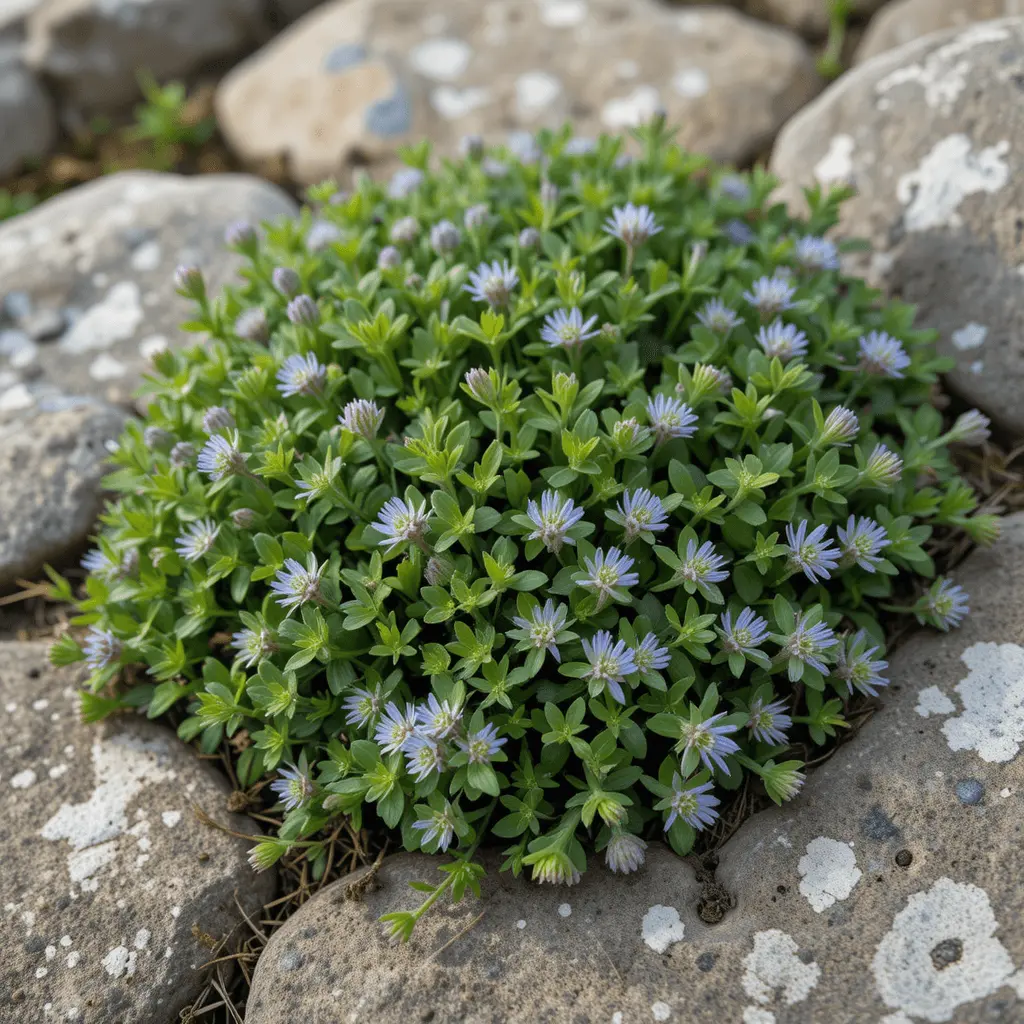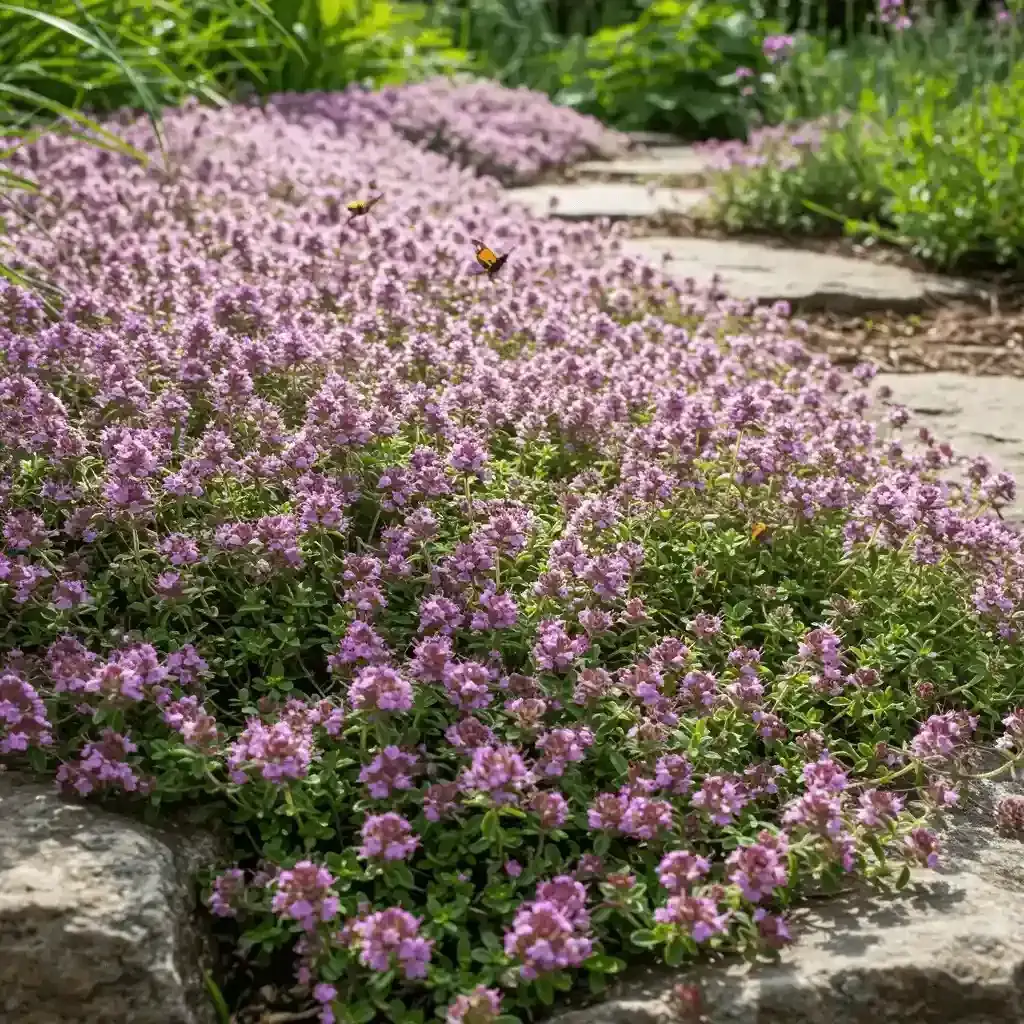Are you looking for a low maintenance, fragrant ground cover to enhance your garden’s beauty? Creeping thyme is an excellent choice, offering a versatile and visually appealing solution.
This hardy, spreading plant not only adds a lush carpet of greenery but also fills your garden with its delightful aroma. To get the most out of creeping thyme seeds, understanding the basics of planting and care is essential.In this article, we will guide you through the process of planting creeping thyme, caring for it, and exploring its various uses in landscaping.
Key Takeaways
- Learn how to plant creeping thyme effectively.
- Discover essential care tips for maintaining healthy creeping thyme.
- Explore popular varieties of creeping thyme.
- Understand how to troubleshoot common issues.
- Get inspired with creative landscaping ideas using creeping thyme.
Understanding Creeping Thyme
This aromatic herb, creeping thyme, is not only beautiful but also beneficial for the ecosystem. It is a low-growing, spreading groundcover that can thrive in various conditions, making it a popular choice among gardeners.
Origins and Characteristics
Creeping thyme, known scientifically as Thymus serpyllum, originates from Europe and North Africa. It is characterized by its tiny, fragrant leaves and delicate pink to purple flowers that bloom in the summer. The plant’s ability to form a dense mat makes it an effective weed suppressant. Red creeping thyme is a popular variety, known for its vibrant red flowers and robust growth habit.
| Characteristics | Description |
| Scientific Name | Thymus serpyllum |
| Origin | Europe, North Africa |
| Growth Habit | Spreading, dense mat |
| Flower Color | Pink to purple, red in some varieties |
Benefits in the Garden
Creeping thyme offers several benefits in the garden. Its dense growth habit suppresses weeds, reducing the need for mulch or other weed control methods. It is also drought-tolerant, making it an excellent choice for water-conscious gardening. Additionally, creeping thyme attracts pollinators, such as bees and butterflies, enhancing the biodiversity of your garden. With its low maintenance requirements and aesthetic appeal, creeping thyme is an excellent addition to any garden landscape.
Popular Varieties
If you’re looking to incorporate creeping thyme into your landscape, you’ll find that certain varieties are more sought after than others. Creeping thyme’s diversity is one of its most appealing aspects, offering a range of colors, fragrances, and growth habits that can suit various garden needs.
Red Creeping Thyme
Red creeping thyme is a standout variety, cherished for its vibrant red flowers that bloom in early summer. This variety not only adds a pop of color to gardens but also emits a pleasant fragrance when walked upon or brushed against. It’s an excellent choice for areas between pavers or as a border plant, where its beauty and fragrance can be fully appreciated.
Other Noteworthy Varieties
Beyond red creeping thyme, other varieties like Thymus serpyllum (also known as wild thyme) and Thymus coccineus offer different flower colors and growth patterns. Some varieties are more compact, while others spread more aggressively, making them suitable for different landscaping needs. Exploring these options can help you find the perfect creeping thyme to match your garden’s unique conditions and aesthetic.
How to Plant Creeping Thyme

Whether you’re looking to create a lush carpet of thyme or simply add some fragrance to your garden, planting creeping thyme is a straightforward process. Creeping thyme is a versatile and hardy herb that can thrive in various conditions, making it a great choice for gardeners of all levels.
Best Time for Planting
The best time to plant creeping thyme depends on your location. In general, spring and early fall are considered ideal because they offer mild temperatures and adequate moisture. Avoid planting in the extreme heat of summer or the cold of winter, as this can cause stress to the young plants.
Ideal Soil and Light Conditions
Creeping thyme prefers well-draining soil and full sun to partial shade. It can thrive in poor soil, making it an excellent choice for areas where other plants may struggle. Ensure good drainage to prevent root rot, a common issue in wet conditions.
Starting from Seeds vs. Established Plants
You can start creeping thyme from seeds or use established plants. Starting from creeping thyme seeds can be cost-effective, especially when using bulk creeping thyme seeds for larger areas. However, established plants provide quicker results. Consider your budget and timeline when deciding.
Using Bulk Creeping Thyme Seeds Effectively
When using bulk creeping thyme seeds, spread them evenly over the prepared soil surface. Lightly rake the seeds into the soil to ensure good contact. Keep the soil moist until germination, which typically occurs within 1-3 weeks.
Essential Care for Creeping Thyme
To keep your creeping thyme thriving, it’s essential to understand its specific care requirements. Proper care will ensure that your creeping thyme remains healthy, fragrant, and visually appealing throughout the growing season.
Watering Guidelines
Creeping thyme requires careful watering to prevent overwatering, which can lead to root rot and other issues. Water your creeping thyme when the top inch of soil feels dry to the touch. Avoid getting water on the leaves to prevent fungal diseases; instead, water at the base of the plant.
Fertilization Needs
Creeping thyme benefits from light fertilization. Feed your creeping thyme with a balanced, water-soluble fertilizer during the growing season (spring and summer). Dilute the fertilizer to half the recommended strength to avoid burning the roots.
Pruning and Maintenance
Regular pruning is crucial for maintaining the shape and promoting new growth of your creeping thyme. After it finishes blooming, trim back the stems to encourage new growth and prevent the plant from becoming leggy. You can also trim it back in the spring to maintain its shape and promote healthy growth.
Additionally, consider dividing and replanting your creeping thyme every few years to maintain its vigor and prevent it from becoming too woody.
Landscaping with Creeping Thyme
Creeping thyme is not just a herb; it’s a landscaping solution for creating pathways, borders, and lawn alternatives. Its versatility, fragrance, and beauty make it an ideal choice for various garden designs. Whether you’re looking to enhance your garden’s aesthetic appeal or seeking a low-maintenance ground cover, creeping thyme can be an excellent option.
Between Pavers and Stepping Stones
Creeping thyme thrives in the spaces between pavers and stepping stones, creating a beautiful, fragrant pathway. To achieve this look, plant thyme in the gaps between your pavers or stepping stones after laying them down. Ensure the soil is well-draining and water moderately.
In Rock Gardens and Borders
Creeping thyme is a perfect fit for rock gardens and borders due to its low-growing habit and ability to thrive in poor soil. It adds a delicate texture and vibrant color to these areas, complementing the rocks and other plants.
As a Lawn Alternative
For those looking for an eco-friendly and low-maintenance lawn alternative, creeping thyme is an attractive option. It can withstand foot traffic and requires less watering and mowing compared to traditional grass.
| Landscaping Use | Benefits | Care Requirements |
| Between Pavers and Stepping Stones | Creates a fragrant pathway, softens hard edges | Moderate watering, well-draining soil |
| In Rock Gardens and Borders | Adds texture, vibrant color, thrives in poor soil | Well-draining soil, trimming after flowering |
| As a Lawn Alternative | Low maintenance, eco-friendly, withstands foot traffic | Less watering, occasional mowing or trimming |
Troubleshooting Common Issues

While creeping thyme is a hardy and adaptable plant, it can still encounter several issues that may affect its health and appearance. To keep your creeping thyme thriving, whether you’ve started it from creeping thyme seeds or established plants, understanding these challenges is key.
Pests and Their Control
Creeping thyme can be susceptible to pests like aphids, spider mites, and root-knot nematodes. Inspecting your plants regularly is crucial for early detection. For minor infestations, spraying with water or using insecticidal soap can be effective. For more severe cases, consider using neem oil or purchasing creeping thyme seeds that are resistant to certain pests.
Diseases and Prevention
Diseases such as root rot and leaf spot can affect creeping thyme, often due to overwatering or poor drainage. Ensuring good air circulation and watering practices can prevent many diseases. For larger scale planting, starting with healthy creeping thyme seeds bulk purchases can reduce the risk of disease. Fungicides can be used as a last resort for severe infections.
By being aware of these potential issues and taking proactive steps, you can maintain a healthy and vibrant creeping thyme garden.
Enhancing Your Garden with Creeping Thyme
As you’ve learned, creeping thyme is a versatile and low-maintenance addition to any garden, offering beauty, fragrance, and a range of benefits. By following the planting and care tips outlined in this article, you can successfully grow creeping thyme, whether you’re starting from seeds or using established plants. For larger areas, consider using bulk creeping thyme seeds to achieve a uniform and lush coverage.
With its numerous benefits and uses, creeping thyme can enhance your outdoor space, whether used between pavers, in rock gardens, or as a lawn alternative. Its low maintenance requirements and fragrant flowers make it an ideal choice for gardeners of all levels. By incorporating creeping thyme into your garden design, you can create a beautiful and inviting outdoor space that you’ll enjoy for years to come.

